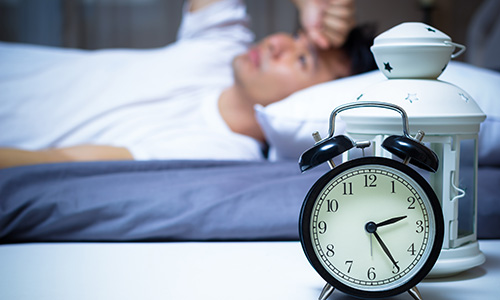How CBT formulas can help you sleep better | Sleep hygiene and stimulus control
- Overview

Most of us will experience a lack of quality sleep at some point, and for some, this endures over the long term.
Whether you’re a new parent, a shift worker, or feeling the effects of stress and anxiety, sleep is often one of the first things to suffer and it can have severe effects on your overall health.
A lack of sleep can:
- cause disruptions to underlying health conditions (such as diabetes and high blood pressure)
- suppress the immune system
- impact mood and mental health
- give you an overall feeling of general fatigue (impacting motivation, efficiency and productivity).
The best CBT techniques for overcoming poor sleep habits
Getting to the root of the problem is important, and small adaptions to your lifestyle can make a big difference to your sleep too. But there’s also a formula that's used by cognitive behavioural therapists to tackle the majority of sleep-disturbing factors.
There are two main interventions that cognitive behaviour therapy (CBT) utilises to help an individual to tackle sleep difficulties:
- Stimulus control works to strengthen the connection between the bed and sleep behaviour
- Sleep hygiene is about forming good sleep habits.
Implementing key aspects of these two interventions can help you to unwind more quickly when you go to bed and enter sleep.
The aspects of the two interventions fit conveniently into the following acronyms:
Stimulus Control (SOUND)
S – Sleep: The bed should be reserved for sleep and sex only. To strengthen the connection between the bed and sleeping, you need to associate it with sleeping. The more additional things that you do in bed (read, eat, work, use your phone, watch TV) the weaker and more diluted the connection between sleep and the bed will become.
O – Observe: While in bed, observe the feel of the mattress beneath you, the comfort of the pillows, and the sense of being ‘absorbed’ into the mattress. Try to make all the sensations associated with the bed and sleep as vivid as possible.
U – Unable to get to sleep: If you can't sleep after 15 to 20 minutes, apply the quarter-of-an-hour rule. Get up, get out of bed and go to a different room and do something not stimulating for 20 to 30 minutes (such as reading a book/magazine, practising mindfulness techniques, working on a puzzle etc) then return to bed.
If you still can't get to sleep after 20 to 30 minutes, get up again and repeat the process until you sleep. This is hard, but necessary. If you lie in bed unable to sleep for long periods, you start to associate your bed with wakefulness and maybe agitation. The only way to break the cycle is by re-aligning the bed-sleep association.
N – No napping: To strengthen the connection between night-time sleep behaviour and the bed, you need to ban any daytime napping. It's essential to associate both the night (and the bed) with sleep, and the day with wakefulness.
D – Decide your routine and stick to it: If you go to bed at 11pm – always have a fixed rising time no matter how well you sleep. The amount of sleep we need differs from person to person, but if you don’t have a fixed bedtime and rising time, the risk is that sleep starts to ‘seep’ into the day and you lose that valuable association between sleep behaviour and night time/the bed.
Sleep Hygiene (ASLEEP)
A – Alcohol and nicotine: Both will interfere with your sleep, so limit these before bed.
S – Sleep environment: Make sure the bedroom is dark enough, comfy enough (pillows, mattress), and quiet enough, with good air quality and appropriate temperature for sleep – you want it to be cool but not cold.
L – Leave it out: Leave laptops, smartphones, TVs, paperwork, or anything that is going to get your mind to race, out of the bedroom.
E – Exercise regularly: Exercise has a wealth of both physical and mental benefits so try and incorporate this into your daily routine, but leave a ‘buffer’ period of at least two hours before heading to bed.
E - Eat a balanced diet: Wakefulness can be caused by hunger, but going to bed too full can also cause the same feeling. As such, make sure you consume a balanced diet throughout the day and incorporate the same buffer period you would if exercising. If you’re up late and haven’t eaten for four to five hours, a small snack before bed might prevent wakefulness due to hunger, but avoid caffeine or anything particularly sugary.
P – Plan for sleep: Have a pre-bedtime wind down. Children sleep well when they have a specific routine associated with bedtime, and this should absolutely continue into adult life. As such, try to start your bedtime routine at least 60 minutes before you go to bed. This period should involve ceasing doing stimulating activities and instead engaging in more relaxing activities – e.g. having a bath, listening to relaxing music, reading etc.
Here are nine simple tips to include in your bedtime routine for a good night's sleep. Or for more sleep advice click here.
Unwind before bed with this calming 10-minute evening meditation. Zoë will guide you through breathwork, mantras and visualisations to help you let go of any worries or tension that may have built up over the day.
Talk to a therapist
If you want further advice, you can book a 30-minute call with one of our therapists at a time and date that's convenient for you by using the calendar below. A therapist will help you to understand why you feel like you do, give you time to explore your concerns, answer any questions you have, and if further therapy is required, we'll discuss what approach is right for you to enable you to feel better.
If you choose to continue with therapy, we can then arrange the support that you need with one of our mental health professionals.
Last updated Tuesday 2 January 2024
First published on Wednesday 5 October 2016


